FAQs on Parrot, Jelly-Bean... Cichlids, Disease Diagnosis
FAQs on Parrot Disease:
Parrot
Cichlid Health 1, Parrot
Cichlid Disease 2,
Parrot Cichlid Disease
3, Parrot Cichlid
Disease 4,
FAQs on Parrot Cichlid Disease by Category:
Environmental,
Nutritional (e.g. HLLE),
Social,
Infectious (Virus,
Bacterial, Fungal), Parasitic (Ich, Velvet...),
Genetic,
Treatments,
Related Articles:
Blood Parrots & Flowerhorn
Cichlids: maintenance and healthcare of two popular hybrid
cichlids by Neale Monks,
Neotropical Cichlids,
African Cichlids,
Dwarf South American Cichlids,
Cichlid Fishes in General,
Related FAQs:
Parrot Cichlids 1, Parrot Cichlids 2,
Parrot
Cichlid Identification,
Parrot Cichlid
Behavior, Parrot Cichlid
Compatibility, Parrot Cichlid
Selection, Parrot Cichlid
Systems, Parrot Cichlid
Feeding, Parrot Cichlid
Reproduction,
|
Check the environment.... When, where in doubt: execute
water changes!
|
|
Question on Blood Parrot Fish - Red Gill Cilia
5/9/17
Hi Team -
I wanted to double check something with you all.( I have read all I can find
related to this issue including posts you all have from a few years ago and find
conflicting info)- I have two Blood Parrot fish in a 45 bowfront tank. I got
them small, they are now about 5 inches long and getting pretty stout. I have
noticed they have the red gill cilia hanging out of their gills now that they
are bigger (one of them has it more so than the other), where it looks like a
ton of short red tentacles hanging out. Was there ever a consensus that this is
a "norm" for them since they are a hybrid? I saw some posting on it a while
back, with pictures and mine look the same. I am regular with water changes (
every 4 weeks) and have live plants in the tank, water parameters good and temp
is regulated about
76 degrees. No other issues with them.
Thank you :)
Kristie
<If these "tentacles" are bright red and feathery-looking, they're almost
certainly gill lamellae. They might be overlong, but what more often happens is
that the gill covers (or opercula) are either too short, damaged, or become
twisted in such a way that the gills underneath are visible. The intensively
farmed Blood Parrot cichlid is much more likely to have this sort of deformity
from birth than most other fish, but even (genetically) healthy fish can be
exposed to physical damage, trauma, or environmental stress that causes the gill
covers to become deformed. Look up "gill curl" on large catfish and Arowanas,
where it is a very common problem that occurs when the fish are kept in a tank
too small for them. In any case, in itself, exposed gill lamellae isn't usually
a problem, but it does allow sensitive tissue to be exposed to the environment,
and the reduction in pressure within the gill cavity does mean that gaseous
exchange (i.e., ventilation) is somewhat compromised relative to normal. So keep
these fish in a well-oxygenated environment, away from anything likely to peck
at them, and take extra care when handling them, e.g., by using a soft, fine net
rather than a coarse one. Hope this helps, Neale.>
Re: Question on Blood Parrot Fish -Red Gill Cilia 5/9/17
Hey Neale, thank you for answering so quickly – I wanted to shoot you a couple
of pics right quick to take a quick look – I think the bigger of my parrot fish
does have a slight gill plate curl of sorts on the left side, which is what the
pictures are of – his left side – I have nothing in my 45gal bow front except
these two parrot fish and a little lobster – he has his own little Stonehenge
rock area and a small log he hangs out in – but I was considering taking him out
and putting him in his own gallon tank to protect him, and my fish as they get
bigger they might try to eat him but also don’t want to put them at risk if it
isn’t a good idea to have t my lobster in there if my fish could be more prone
to disease if the gill lamellae are much more exposed than normal fish?
<Crayfish are never really 100% safe with fish -- or vice versa when crayfish
moult and aren't able to defend themselves. So moving a crayfish to its own tank
is something I usually recommend. But you'll know your own fish better, and if
you think he's safe in his burrow, and he's too small to harm the cichlids, he
may well be fine.>
That being said, it sounds like I should perhaps add a long air bubbler wand or
something to increase oxygenation to make things easier for them.
<I would. Or something similar, perhaps a spray bar for the filter outlet, that
sort of thing.>
I have a BioWheel filter with two biowheels for a 60gal size tank on their
aquarium, and the water circulates a good bit, but will add an airstone wand if
this will help them. I know they are hybrids and I hate that ☹ I took them as a
rescue.
<Understood. Many fish in the hobby are hybrids -- Goldfish, Angelfish,
Discus, Guppies, Mollies, Platies, and Swordtails to name but a few! But Blood
Parrots do seem to have more than their fair share of detractors -- as well as
some persistent health problems.>
I am sorry if the pics are big – they were the best I could get yesterday and
just wanted you to take a fast look -THANK YOU Neale – you all are GREAT!!
<Glad to help, and good luck! Neale.>
|
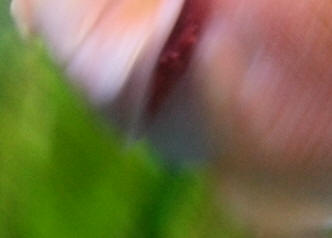
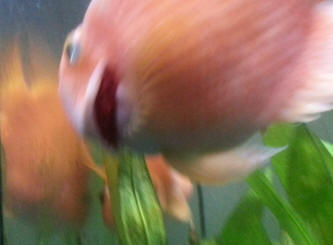 |
Parrot fish keeps swimming upside-down
11/15/16
Hi
Please help I have a parrot fish and he has been swimming upside-down for a
while.
<Is this a marine Parrotfish, family Scaridae; or else one of those hybrid
cichlids sometimes called Parrot Cichlids?>
I Googled and tried to do the Epsom water thing for 15 minutes a lot of times.
It doesn't seem to help much. He is now more just flat on his side and not
swimming. This has been going on for about a month. I have him in a separate
tank alone now. What should I do?
Marina
<Assuming it's one of the cichlids, let me have you do some reading. Start here:
http://www.wetwebmedia.com/FWSubWebIndex/FHParrotCichArtNeale.htm
Virtually all problems with Parrot Cichlids come down to environment and
diet. Any problems with these are exacerbated by their skeletal
deformities, which among other things, mean they can't balance easily when
constipated or, less commonly, suffering from gastro-intestinal infections.
Review, and act accordingly. If you choose to write back, be sure to tell us
things like the size of the tank, diet, and water quality (crucial, this!)
otherwise we can't really offer any useful help. Let me also direct you here:
http://www.wetwebmedia.com/ParrotDisTrtF.htm
Treatments for these cichlids are most often a combination of Metronidazole,
Epsom Salt, and optimised water quality. So even if you can't identify the
problem, using these three tools, simultaneously, should help.
If we're talking about marine Parrot Fish, Scaridae, let me have you read here:
http://www.wetwebmedia.com/parrotfi.htm
As with most of the larger marine fish, health issues come down to environment
99 times out of 100, so review the obvious things like salinity and temperature,
as well as dissolved metabolites (nitrite, ammonia). If these check out, please
write back, again describing the marine system, filtration, water chemistry
parameters, etc. Hope this helps, Neale.>
|
Blood parrots gills are cherry red
8/2/16
Hello,
I have a 5 year old blood parrot and two blood parrots that are
approximately 7 months old. My younger ones have bright red fluff, strings
hanging from behind their gills. I have treated with antibiotics twice
with no change. My five year old blood parrots gills are fine so I feel it
may not be gill flukes. I have no idea? They have been eating fine. It
has been a month now. Please help if you have any suggestions.
Thank you,
Jessica
<I'm really not sure about this. The photos aren't sharp enough to see
anything useful. If this fish is feeding well and otherwise healthy, I'd
probably adopt a wait-and-see approach for now. Is the fluffy red stuff
getting worse? Is it the same bright red colour as the actual gill
filaments? If it is the same as the gill filaments, suggestive of a healthy
flow of blood to the fluffy tissue, I'd wonder if it wasn't just a
deformity of some sort, whether genetic (common with these inbred hybrids)
or as a result of some environmental stress (a too-small aquarium for
example). Either way, nothing much to be done. If it's different to the
gill filaments, perhaps a duller red suggestive of dead tissue, then I'd
perhaps treat for Gill Flukes just to be on the safe side. Do look out for
visible specks on the gills suggestive of Gill Lice and other copepod-type
parasites. Although rare in aquarium fish, you do see them on fish farms
from time to time, and it's not impossible for them to get into aquaria or
ponds. Hope this helps, Neale.>
Re: Blood parrots gills are cherry red
8/2/16
Thank you so much for your reply. I have a 55 gallon and have 3 blood parrots.
It's odd how a month ago this just developed. The redness is bright and has a
fluffy, feather like movement. Yes, I agree the picture doesn't show clearly
what it actually looks like. I never heard of this deformity or whatever it
maybe. No one has heard or has a name for this as far as I know.
<There is a problem called "Gill Curl" that occurs in some other fishes when
kept in relatively small tanks. Not saying that's the issue here, but it is
certainly true that the environment can affect the development of the gills,
sometimes in odd ways.>
I truly appreciate your reply��
<Most welcome. Neale.>
|
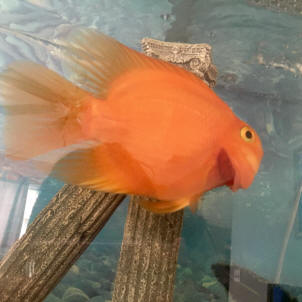
 |
|
Re: Blood parrots gills are cherry red 8/4/16
Hello Neale,
<Jessica,>
I have looked on-line and seen pictures of it. There is no treatment or name for
it from what I see. It's definitely gill damage of some kind and the gill is a
little curled because of red feathery, stringy fluff coming out.
<Understood. Will either die and fall off, or heal up but remain deformed. Can't
think of any treatment as such.>
I think it stemmed from a day the power went out for a couple hours and I wasn't
home. The two younger BP's were affected and the older fish wasn't... Who knows.
The gill damage has been done for whatever the reason.
<Given the gill filaments are normally hidden away behind the gill covers, to be
pulled away or torn, the gills would have to be seriously beaten up! Really,
setting aside large parasites that might damage gill tissue, I think you're
choosing between fighting or clumsy handling (e.g., netting).>
The fish appear fine, just look sick. I was hoping there would be a fix to the
problem but I guess it is what it is��
<Quite so. Cheers, Neale.>
|
|
Strange growth on otherwise healthy Flowerhorn... Parrot
4/7/16
Notice white growth just below Jr's gill. He's otherwise very healthy and
exhibits normal behavior, he just started showing a growth a couple weeks
ago. Please, if you have any idea why or what to do about it let me know.
I'm going to email a couple more picks
<Does look like necrotic tissue rather than a parasite. So some combination
of environment and physical damage triggering a bacterial infection. Do
review living conditions, tankmates and diet. Most problems with Flowerhorns
come down to these. Do READ; starting here...
http://www.wetwebmedia.com/fwsubwebindex/FHParrotCichArtNeale.htm
http://www.wetwebmedia.com/fwsubwebindex/flowerhorndisfaq.htm
...and following the links on top of those pages. Cheers, Neale.>
|
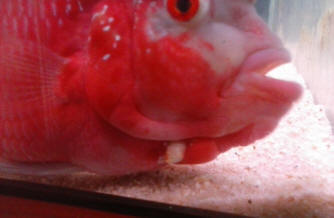
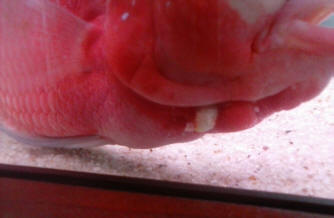 |
|
re: 4/7/16
<Is there prev. corr. to this? B>
re: ? 4/7/16
Nope... It just started like 2.5 wks ago. But check this out... About 3
hours ago i was doing a couple water changes, Jrs tank included. Now Jr
tries his best to beat my hand
<Territorial aggression; sometimes misunderstood as play.>
and syphon up while working in his tank and i noticed the growth didn't look
as big. So i picked him up and checked closer and it appeared to be smaller.
Here it was like a clear sack full of sand hanging out of his gill plate. I
know this sounds strange, but I've never seen anything like that before! I
use sand as the substrate, and he's always digging in it and pushing it
around so i don't know if he had some get stuck in his gills and his body
was naturally trying to remove it or what.
<Many cichlids are sand-sifters, so do ensure their substrate is smooth,
clean, and not so deep anoxic pockets can develop. Smooth silica sand with
10% coral sand, or a slightly alkaline river sand, would both be good
choices for hybrid Central American cichlids.>
So now at this time its gone, and i am now baffled... How bout you?
<I've no idea what the "nope" refers to... so really, this entire message is
baffling to me! Cheers, Neale.>
? Parrot; hlth 4/7/16
He has a 75gal all to himself and no decor to bump into. His temp stays 83
degrees, I change the water once a week, feed grand sumo and grand sumo red,
and freeze dried krill.
<Does need more variety than this... what sort of fresh greens/plant foods
are you providing? These are necessary for good health, good colouration...
bear in mind that these cichlids (or their ancestors, at least) are
omnivores, not carnivores, and fibre, vitamins, etc. are all important to
them.>
His tank has a HOB and Fluval external going. The mystery growth noticeably
grown in two weeks from out of nowhere. I look closer and it appears another
is starting too. I've researched so many sites on care, and
raised him from 1". Im running 7 tanks of different fish successfully,
including two other beautiful Flowerhorns I've raised for years, so im not a
rookie or greenhorn. But this growth thing is a first. Its GOTTA be
parasitic, id bet on it....or a tumor. Is that possible with fish?
<Yes.>
Lol!
<Again, let me have you do some reading...
http://www.wetwebmedia.com/fwsubwebindex/FHParrotCichArtNeale.htm
Nothing remotely unusual about the symptoms described, and almost certainly
environmental... your job is to establish what isn't quite right, and act
accordingly. Cheers, Neale.>
|
blood parrot; one okay, one not so 9/26/15
Hi I have 2 blood parrots. They are in a 60 gallon heated at 81 degrees. The
water parameters are perfect.
<Need values; not subjective evaluations>
But the larger of the two looks like it has gotten its tail dirty. Black marks.
Could he have burned himself on the thermometer?
<Possibly>
Or is he sick? He/she doesn’t act sick at all. Eating like a pig just as
friendly as always.
<Mmmm>
I am worried I would hate to lose them.
Thank you Danielle
<Most likely beat by the other one if only the one is mal-affected; I'd separate
for a few weeks. Bob Fenner>
Sick blood parrots 11/18/14
My 3 blood parrots seem to be lethargic laying on the bottom or
staying in their hiding places unless being fed. One of them is
actually changing colors from light orange to almost white on his body.
Water is good other than a slight raised nitrate. I added an
algae eater several weeks ago.
They do not have white spots like an ich infection. Water ranges from
78-80 degrees. Any ideas?
<Without some meaningful statistics it's hard to say anything useful.
Blood Parrots do sometimes fade in colour for no apparent reason. But
if they go lethargic as well, review the environment. I would
check nitrite (must be
zero) and pH (7-8) first of all. I'd lower the temperature to 25 C/77 F,
and also increase water circulation to maximise oxygen concentration.
I'd check the water flow rate is good, rinsing filter media gently if
necessary. Adding a second filter is rarely a bad idea when fish look
"off colour" as it improves oxygen levels and reduces the risk of water
quality problems. I'd also have you reading:
http://wetwebmedia.com/FWSubWebIndex/FHParrotCichArtNeale.htm
Nothing improves animal healthcare like knowledge. It's the silver
bullet.
Look for what you're not doing right, and chances are, that's the
problem.
As a side note, Plecs aren't always good companions for large cichlids,
and Gyrinocheilus aymonieri very often not, if they harass the fish,
"latch on" to graze on mucous, or simply make the filter work twice as
hard. Cheers,
Neale.>
Sick blood parrots 11/18/14
My 3 blood parrots seem to be lethargic laying on the bottom or staying
in their hiding places unless being fed.
<Something wrong here environmentally... CHECK your water quality,
institute sequential (daily) partial water changes>
One of them is actually changing colors from light orange to almost
white on his body.
<ACT NOW>
Water is good other than a slight raised nitrate.
<... how much?>
I added an algae eater several weeks ago.
<... what type/species?>
They do not have white spots like an ich infection. Water ranges from
78-80 degrees. Any ideas?
<All sorts. Need data. Bob Fenner>
My PARROT FISH... hlth., no data
6/6/13
I have three blood parrot fish. The last two days they haven't
eaten and are laying on their sides.
<Something wrong here. DO a massive (like 50%) water change... check
your system for faulty gear, ammonia...>
Sometimes they lay all together and have been staying there for long
periods. Then they separate and just stay on their sides. We've
had these fish for a very long time and really love having them. One of
them is worse then the others and we're sure is dying. Anything we can
do??
<Yes; the water change/s... and write back re your water quality tests,
what equipment you have, décor (some may be toxic), foods/feeding. Have
you read here:
http://www.wetwebmedia.com/FHParrotDisArtNeale.htm
and the linked files above? Do so. Bob Fenner>
Parrot Fish Age Question /Illness
4/20/13
Hello!
<Brenda (my oldest sis name also)>
I currently have 2 parrot fish that are approximately 10+ years old
living in a 75 gallon tank. The water quality is good, gets
partially changed every 3 weeks (including filters) (approx 25 %) and
has been since I set up the tank 10 years ago. The last 2 weeks
one of the fish has been off food so I did a partial water change and no
improvement. The past 24 hours he has been sitting on the bottom
of the tank not doing much.
<I'd be measuring water quality... e.g. is there more than 20 ppm of
nitrate here?>
I'm not sure what to do next?! At first I assumed perhaps he's
dying of old age, but would hate to make that assumption.
Any suggestions?
<... read here:
http://www.wetwebmedia.com/FHParrotDisArtNeale.htm
and the linked files above. Bob Fenner>
Brenda
Re: Parrot Fish Age Question /Illness
4/21/13
Bob
<Bren>
Thank you for the quick response but unfortunately, my fish died during
the night:(
<Ahh!>
I do keep a close eye on water quality and have for the past 10 years
and the fish have been extremely healthy with no problems. I know
how easy it is for fish to get sick with overcrowding and poor water
quality and that all appears to be good.
<Mmm... well...>
Is it possible he died of old age? I've done some research on your
website and I find a lot of references to 7 years of age as being "old"
but it doesn't say what the typical life span is for the parrotfish.
<Ten years is not uncommon, but a good long time. Could be "cumulative
genetic/replicant defects" (senescence) at play here...>
As usual I appreciate all your help!
Brenda
<Certainly welcome. BobF>
Jellybean Parrot has bumps/white spots, please help me
identify
Jellybean Parrot Cichlid With HITH 11/21/10
I have a jellybean parrot fish that is about 7 years old. It has
recently developed white bumps/spots on its head. My husband thought
the change in her appearance was due to age and so he dismissed it. He
thinks he first noticed them about a week ago. I've attached two
photos. The large bump in the center of her head is actually a cluster
of bumps. It is white on the surface and somewhat fluffy in appearance
with a red coloring underneath. As I'm hoping you can see in the
photo, it is a protruding growth. There is a line of smaller white
spots along the back of her head.
The top of the fin on the left side of the second photo also appears to
be abnormal in shape/color. The pale areas of the body are her normal
coloring. She is eating and behaving normally.
She is in a 55 gal tank with a rainbow, a catfish (I don't remember
what breed) and several tetras. The last water change was 5 days ago
and may have been a little overdue but not much. We do not have a
quality test kit, only the simple strips. The water had not been tested
in a long time and when I tested tonight the levels were not good. The
nitrate level was 80, nitrite 3, pH 7.2, alkalinity 80 and the water
was hard 150. My husband is doing a 25% water change now. The
temperature of the tank is 76 degrees.
I've tried to research the problem online but have only become more
confused. I do not want to treat her for the wrong thing and cause more
problems. I'd greatly appreciate your opinions.
Thank you! Kim
< Your cichlid has Hole-In-The-Head Disease. First get a nitrate
test kit.
Get the nitrates down to under 20 ppm with water changes. The lower the
nitrates the better your fish will be. In a hospital tank treat with a
combination of Metronidazole and Nitrofuranace. If you fish is still
eating
then start feeding medicated foods with these medicines in it. I would
still treat the water too. The key to a full recovery is an early
treatment.-Chuck>
|
black spots and black colouring in red parrots body
and upper lips -- 1/27/10
I bought 4 red parrots and 2 Oscar babies four days back ....
they are good and eating well and fighting well .... hiding well
also in this four parrots one parrot was having a black spot on
its upper lip when I was getting it ... and now I noticed they
are having similar spots on its belly also and is black in
colour...I never noticed this when I was getting this.... but the
fish is normal in eating and playing ... but its a bit aggressive
than other fishes its always fighting and butting other fishes
.... it is the biggest fish in all the fishes ... I don know
weather its a disease or just colour of the fish . pls help .
<Hello Kareen. Before going any further, can we please remind
you to send image attachments each less than 500 KB in size? We
have only limited e-mail storage space here, and if people send
us 11 MB of images -- as you did -- that storage space gets
filled quickly. That means other people's messages will be
bounced back. We do specifically state this on the page where you
found our e-mail address. Anyway, "Black Patch Disease"
on Blood Parrots is fairly common. Unfortunately, it isn't
one specific thing. Since these cichlids are hybrids, they are
genetically variable. One of the ancestor species of the Blood
Parrot was Amphilophus citrinellus, a species that often changes
colour. So sometimes Blood Parrots develop odd "calico"
patches, just like Amphilophus spp. Obviously, there's
nothing you can do about this. On other occasions, black patches
are likely ammonia burns, just like you see on Goldfish. If you
have non-zero levels of ammonia, this could very easily be the
problem. Fixing the water conditions will prevent this, and over
time, discoloured scales MAY be replaced. Finally, opportunistic
infections such as Finrot can cause discoloured patches, just as
they can on any other fish. Certainly fighting can lead to
damage, and wounds can become infected, especially if ammonia and
nitrite levels aren't zero. Ironically given how big your
photos were, they're actually too blurry to be 100% sure
what's going on. I'd plumb for either genetics or ammonia
burns. Cheers, Neale.>
|
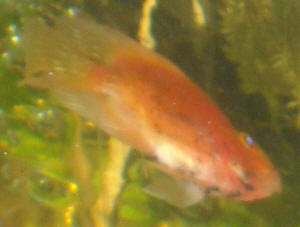
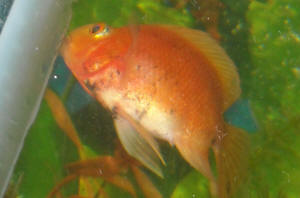 |
Re: black spots and black colouring
in red parrots body and upper lips -- 1/27/10
thank you very much . I reside in India in my place the local pet
shops do not have any instrument to check water quality ... what
else can I do ...
pls help ...
<If you cannot check water chemistry and cannot check water
quality, you must be conservative. Do the following:
[1] Keep the tank lightly stocked. Allow 80-100 litres per Blood
Parrot.
[2] Add Rift Valley Salt Mix to each bucket of water to raise the
pH and hardness levels. Add to each 5 gallons/20 litres of new
water the following:
* 1 teaspoon baking soda (sodium bicarbonate)
* 1 tablespoon Epsom salt (magnesium sulfate)
* 1 teaspoon marine salt mix (sodium chloride + trace elements)
Stir into each bucket of water, and then do your normal water
changes. Do not add directly to the aquarium, and do not change all
the water all at once!
[3] Use a robust filtration system. Aim for a turnover rate of not
less than 4 times the volume of the tank per hour, and ideally 6
times the volume of the tank. In other words, if the aquarium is
200 litres in size, the filter should be rated between 800 and 1200
litres per hour.
[4] Do weekly water changes of 25%.
[5] Do not overfeed; ideally, skip a day. Use food sparingly, and
remove uneaten food within 5 minutes. Better to feed two small
meals per day than one big meal.
[6] Do not use any sorts of live foods; only use pellet foods,
vegetables, and things you'd eat yourself (like little bits of
prawn or tilapia filet).
Hope this helps, Neale.> |
Problem with Red Parrot fish 9/9/08
Hi Bob
<It's Neale this morning.>
You recently advised us on a 'swim bladder' problem with a Red
Parrot fish (see e-mails below) and we wondered if you could help us
with another problem with our largest Red Parrot 'Pinky'
<My least favourite fish on the planet I'm afraid, but will do
my best. Do understand these things are grossly deformed hybrids prone
to all kinds of diseases and syndromes because of it. They aren't
easy to keep and certainly aren't suitable for beginners to the
hobby.>
About 3 weeks ago we noticed that Pinky had developed a small lump on
the side of her mouth and a week later it had grown into a large red
lump about 3mm across. We have treated the tank with 2 doses of
anti-bacterial infection solution but the lump is still there and she
has now gone very pale and off her food, today I also noticed that she
had a few white spots on her body and fins
<The "lump" could be a variety of things. In cichlids
generally, fighting often takes the form of mouth tugging, and because
Blood Parrots have the aggression of Central American cichlids but not
the stamina or strength, they easily lose out. Their weaker immune
system means that light damage doesn't heal so quickly, and poor
water conditions will make things worse. Despite being sold to
inexperienced fishkeepers as funky pets, these are fundamentally large,
Central American cichlids that need systems measured upwards of 180
litres/50 US gallons to thrive. Like any cichlid, water quality must be
excellent, in particular zero ammonia and nitrite. In common with
Central American cichlids they are somewhat adaptable with regard to
water chemistry, but soft/acidic conditions must be avoided. My guess
is that this fish injured its jaws, and you have something like Mouth
Fungus (actually a bacterial disease) or Finrot setting in. Easily
cured using suitable medications. In the UK I'd recommend a brand
called eSHa 2000, which is safe to use in combination with eSHa EXIT,
the manufacturers Whitespot/Ick medication. No cure will work if the
fundamental problems with the tank aren't corrected as well, so
review these. Tell me more about your tank, the other fish in the
system, what filter you use and I can comment further if
required.>
I know that the 'white spot' can be treated as we have had to
treat it before but don't know what the other conditions could be
and how to treat them - I am very unsure about putting too many
treatments in the tank and subjecting the other fish to too much
stress
<Medications are only safely used in combinations if expressly
stated as such by the manufacturer (or a vet). Do also remember to
remove carbon if you were tricked into using that stuff in your
freshwater aquarium (for most freshwater tanks the stuff is redundant
assuming decent filtration and weekly 25-50% water changes).>
Mark & Sam
<Cheers, Neale.>
Re: Problem with Red Parrot fish 9/13/08 Hi Neale Thanks for coming
back to me <You're welcome.> We tried to get hold of some of the treatment you
suggested but it is proving very hard to local someone local who has heard of it
and can source some for us <Try online. eSHa products are widely sold.> We have
however just finished our 2nd bacterial treatment and replaced the media in the
filter (inc carbon I'm afraid although I am considering not bothering once the
fish are better) <Do understand carbon MUST be removed while treating the fish.
Carbon absorbs (or more precisely adsorbs) organic chemicals such as dyes, and
this renders any treatment useless. One of many reasons I recommend against
using carbon in the average freshwater aquarium.> We also did a 30% water change
and the sore on Pinky seems to have started to heal and although she still
doesn't have an appetite the other fish have and she is starting to chase the
other fish around again <Good.> We have however noticed that the other parrots
fins have started going black!! <This may be normal. Many Blood Parrots have
speckled/mottled fins. A photo would help.> Any ideas what this could be?
<Provided the fins are entire and show no signs of rot or fungus, I'd not be
alarmed.> Our tank is 240 litres with a Fluval 305 external pump, aerator stone
and houses 1 large(Pinky) and 2 small parrots, a gold Severum, 2 silver dollars
and 2 Plecs Mark & Sam <Cheers, Neale.>
Re: Problem with Red Parrot fish 9/21/08
Hi Neale
<Good evening!>
Just thought I would let you know all our fish are doing great now - we
found out that the pump had become almost completely blocked up (which
it has never done before between full cleans) - once I had cleaned the
pipes out the fish were back to normal within a couple of days
<Well, all's well that ends well! Does sound as if water
circulation was the issue. Do check the pump each time you clean the
filter, which should be every couple of months or so.>
Many thanks for help
<Have fun with your fishies!>
Mark & Sam
<Cheers, Neale.>
|
Jelly-Bean cichlid 9/29/08
Hello there. First of all, thank you for taking time to help
me!
I have an 9 year old Jelly-bean cichlid named Walter. He's
been doing great up until a week ago. He seemed fine and then one
day started to have rapid gill movement and his color was really
dull. So, I tested the water and did a water change. He seemed
find for a few days and then I noticed next to his left eye it
looked like a black worm on the INSIDE of the scales. I
didn't think anything at first until a day later it went away
and then came back again. Sometimes it looks like it might pop
out of his scales, but then goes back in. Then two nights ago I
noticed his left eye was a little swollen. Its not severe, but
its just enough to notice. (I spend hours with these fish a day.)
He's appetite hasn't changed, and he doesn't seem
lethargic. But I'm worried about that black spot and his eye.
Any ideas? This fish is just like my best friend. I would hate to
loose him... I'm not sure if its important info but, his tank
mate is a HUGE silver dollar and a Pleco. The temp in the tank
stays at 75 degrees. I'm sending you some pics. I hope they
aren't too big... Thank you again!
<Jennifer, please, next time you write, send smaller images!
We do specifically ask people reduce their image sizes to ~500
kb. Your three photos were over 4 MB, and that's a good part
of our e-mail space, running the risk of bouncing back other
peoples' messages because of insufficient space to receive
them. We do ask this at the "front door" where you got
our e-mail address, so please do try and follow our (few, but
necessary) rules before writing. Anyway, it isn't obvious to
me that there's anything seriously wrong with this fish. The
black "worm" is most likely just dead tissue, and along
with any lethargy, excessive gill movement, or swollen eyes are
likely non-specific reactions to some issue with water quality or
water chemistry. To be sure, at 9 years of age your cichlid is
certainly in its "old age" (anything above 10 years is
uncommon with medium-sized cichlids). So broadly speaking I'm
sure you maintain your aquarium well. But do in particular check
the temperature is correct, if there are any unusual pH changes,
and that water quality is good. Old, established tanks often
experience pH drops if you've hitherto relies upon calcareous
media to buffer the pH and create the hard, alkaline conditions
these hybrid cichlids require. Assuming that you have done this,
you may need to remove/replace some of that calcareous media.
Cheers, Neale.>
|
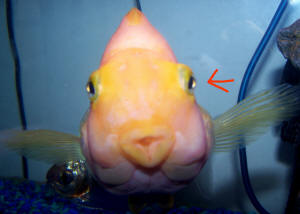
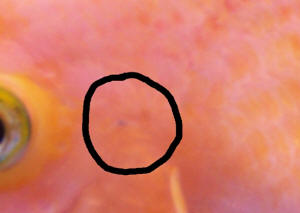 |
Black patches on parrotfish... FW! Cichlids, poor svc. work
11/4/05 Hello Crew! Firstly, I wanted to let you know how wonderful
your website is--it is a gem! I work for a company that has a
fish tank that is serviced by a local company on a monthly basis. They
do a horrible job--I can't even tell you how many fish have died
since I started working here a year ago. I would guess 50, at least.
Unfortunately, no one who works here is a fish expert and we are sort
of at the mercy of the company who does the monthly cleaning. <Fire
them. Either take over the job in-house or hire a capable company>
We
just went through a horrible Ich problem and lost most of the fish in
the tank, including a lovely parrot fish that everyone adored.
<This family (Scaridae) are not easily kept in captivity His mate
survived the Ich, but she now has many black patches on her body,
including a line that runs right down her back. They look like dirty
smudges and they are not raised like blisters. <Likely "stress
markings" When we called the cleaning company, the owner said that
this is normal and happens to all fish on occasion. <... no... Fire
them>
Of course, since we are mere employees and not fish keepers
ourselves, we cannot really argue with this supposed expert. Do you
have any idea what this is? A fungus? <Evidence of poor care...
toxic, incompatible environment, poor nutrition It is definitely
getting worse each day and she is hardly moving around. There isn't
a thermometer on the tank and we don't own any water-testing
equipment so I can't tell you much about the tank except that it is
a 55-gallon freshwater tank. <Oooh... pardon me... a FW
Parrot, as in the tweaked cichlid cross... even worse... these are very
hard to kill... Some of us are very unhappy with this service but it is
not our decision to hire a new company--this company was the cheapest
in the area and that is who our higher-ups decided to go with. I am
suggested many, many times that we have plastic fish instead of real
ones, but management doesn't seem to care about our tank of death
and insists on restocking when something goes wrong. Any
suggestions/ideas would be appreciated! We would hate to kill this
parrotfish, too. Laura <Learn a bit (not hard to do) and do the
maintenance yourself... Please read here: http://www.wetwebmedia.com/FWSubWebIndex/fwsubwebindex.htm.
Follow the blue/linked files through set-up, maintenance and all there
is there on cichlids, the family including the Parrot. Bob
Fenner
| Parrot Cichlids With Rough Scales
5/10/07 Hi, Please help if you can. I have a 7
blood parrot fishes, and have included photographs. Please do not
mind the dirty glass.. :-) But I am currently having a slight issue
that I hope you can help me answer. I'm looking at the scales
of my fish, and am trying to remember if they had smoother scales
before. I have had a run in with dropsy in my other
tanks here about a year ago, and unfortunately, lost a
few dozen guppies and Betta fish. And noticeably, they all ended up
"pine coning" , and hope that this is not the case for my
much more larger and treasured fish. But nevertheless, here is my
dilemma, and was wondering if you guys can see if theses scales
look a bit off, for blood parrot fishes, and if you have any advice
I can use to help save them if they are indeed, not right.. Any
help, so much appreciated. Thanks Kee. < I looked at your photos
carefully and could not tell if the scales were any rougher than on
a standard parrot cichlid. Usually with bloat or dropsy the fish
stop eating and the stomach extends. If your fish are eating
normally then I think they probably fine.-Chuck> |
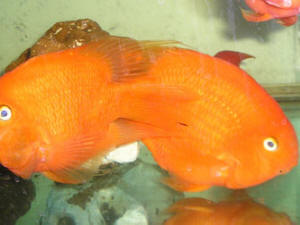
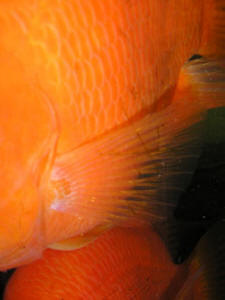 |
|
|

